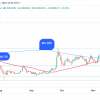Is Bitcoin on the verge of a major breakout or will September’s economic data confirm the bearish sentiment that has kept the market in limbo for weeks?
Table of contents
Bitcoin Awaits Next Signal
The cryptocurrency market has been stagnating for the past few weeks, with prices stubbornly stuck in a narrow range.
Bitcoin (BTC) has been hovering around the $60,000 mark, often dipping just below it and struggling to hold above it. As of September 3, BTC is trading around $57,500, a level it has visited multiple times over the past month.

Similarly, Ethereum (ETH) has encountered strong resistance at $2,500, barely breaking out of the range despite attempts to break out, and is trading at $2,450 at the time of writing.

This sideways price movement has many investors and traders on edge, especially as we approach September, a month filled with important events that could significantly impact the direction of the market.
These include the US presidential debate, the release of consumer price index (CPI) data, the release of producer price index (PPI) data, and the Federal Open Market Committee meeting.
The CPI and PPI data are particularly important because they are likely to play a key role in the Federal Reserve’s upcoming interest rate decision. If inflation pressures appear to be easing, the Fed may choose to cut rates.
With all this in mind, let’s dig deeper to understand what to expect, what the likely consequences are, and how things might play out next.
Inflation indicators determine the Fed’s next move
The U.S. Consumer Price Index (CPI) and Producer Price Index (PPI) are the two most important economic indicators that could influence the Fed’s interest rate decision this month. Understanding these numbers is key to understanding how the market might react in the coming weeks.
The August CPI data, due out Sept. 11, is a key measure of inflation, tracking how prices for everyday goods and services change over time.
In July, CPI inflation was 2.9%, down slightly from 3% in June, suggesting that inflation is cooling gradually. However, the Fed’s goal is to bring inflation down to 2%, so the August CPI will be closely watched.
If that figure falls below 2.9%, it would mean inflation is moving in the right direction, potentially easing pressure on the Fed to keep interest rates high.
The following day, September 12, data on the producer price index (PPI) will be released. The PPI measures the average change in the selling prices received by domestic producers for their products, which provides an indication of inflationary pressures in the supply chain.
In July, the producer price index showed a sharper-than-expected decline, with the annual rate falling to 2.2%, significantly lower than the previous period’s 2.7%.
The core producer price index, which excludes volatile food and energy prices, also fell sharply, to 2.4 percent year-on-year, compared with expectations for 2.7 percent.
The importance of these inflation-fighting measures cannot be underestimated, as they will have a significant impact on the Fed’s interest rate decision at the upcoming FOMC meeting on September 18.
At its previous meeting, the Fed decided to keep rates on hold, setting its current target range between 5.25% and 5.50%. However, Fed Chairman Jerome Powell hinted that the central bank is nearing the end of its rate-hike cycle if inflation continues to decline.
The market is currently split, with 67% expecting a 25 basis point cut to a new target rate of 5.00-5.25% and 33% expecting a deeper 50 basis point cut, bringing the rate down to 4.75-5.00%, according to the CME FedWatch tool.
A 25 basis point rate cut would likely mean the Fed is entering a typical easing cycle, which could provide market stability.
On the other hand, a more aggressive 50 basis point cut could trigger an immediate rally in Bitcoin prices as investors react to the potential for lower borrowing costs and more accommodative monetary policy.
Second presidential debate: a turning point?
As the second US presidential debate approaches on September 10, the cryptocurrency market is bracing for possible changes in sentiment and direction.
This debate will be especially significant for the crypto community as it will feature two candidates with very different histories and views on the industry.
On the one hand, we have Republican candidate Donald Trump, who has taken a surprisingly pro-crypto stance during this campaign.
Just a few years ago, Trump called Bitcoin a “fraud” and expressed concern about its threat to the U.S. dollar. However, in a dramatic turn of events, he has now become an ardent supporter of the crypto industry.
In a keynote speech at the Bitcoin conference in Nashville, Trump promised to fire SEC Chairman Gary Gensler, a figure widely criticized in the crypto community. He also outlined his plan to create a national strategic Bitcoin reserve and promised support for American crypto miners.
These bold promises position Trump as a candidate who could potentially make big changes to how the US government interacts with the cryptocurrency industry.
On the other hand, Vice President Kamala Harris has remained relatively silent on the issue of cryptocurrencies throughout her campaign, which has led to much speculation about her stance.
However, recent comments from her senior campaign adviser Brian Nelson have shed light on her views. Nelson indicated that Harris intends to support policies that allow emerging technologies, including cryptocurrency, to continue to grow. While the statement was vague, it marks the first official acknowledgement of the crypto industry by the Harris camp.
The timing of these statements is critical, especially given that the Democratic Party’s latest document makes no mention of cryptocurrencies at all – a fact that has not gone unnoticed by the industry.
This omission, coupled with Harris’s recent comments, has led to mixed interpretations. Some see it as a positive sign that suggests non-intervention, while others see it as a continuation of the Biden administration’s policies, which are considered less favorable to the crypto industry.
Additionally, the recent backlash over misinformation regarding Harris’s alleged support for taxing unrealized capital gains has further clouded perceptions. While the rumor was unfounded, it has caused concern in the crypto community, further clouding her position.
Meanwhile, the debate comes amid increasing regulatory scrutiny, with the US Securities and Exchange Commission (SEC) recently issuing a Wells Notice to NFT marketplace OpenSea, signaling potential legal action.
In this context, Trump’s recent moves, such as the announcement of a new set of digital trading cards (ironically hosted on OpenSea), have further cemented his image as a cryptocurrency supporter.
The timing of the notice’s release has fueled speculation that the Harris administration may maintain or even increase regulatory pressure on the crypto industry.
For crypto investors, Trump’s strong performance will likely be seen as an optimistic signal, given his clear pro-crypto stance and promises of deregulation.
In contrast, Harris’s debate victory may be harder to interpret. While her recent comments indicate a willingness to support the industry, the lack of specific policy details and ongoing regulatory action raise questions about what a Harris administration would mean for cryptocurrencies.
Where might the cryptocurrency market go next?
With the cryptocurrency market at a critical juncture, many experts are speculating on how things might play out next.
One such indicator is Santiment, a well-known cryptocurrency market analytics platform that recently noted that Bitcoin is showing signs of life.
Santiment noted that as fear, uncertainty, and doubt (FUD) rises among traders, especially with a noticeable increase in bearish sentiment, there is a chance that this pessimism could actually set the stage for a rebound. In other words, when everyone starts feeling bearish, it could be the perfect time for a market rebound.
📊 Bitcoin shows signs of life as S&P 500 pauses for Labor Day. Signs of crypto rally without stocks to back it up are a promising hint of sector strength. Coupled with growing bearishness among traders and FUD, there are promising signs that an upcoming bounce is near. pic.twitter.com/d3ykTTSHY0
— Santiment (@santimentfeed) September 2, 2024
Crypto analyst Ali Charts, backing up this cautious optimism, noted that top Bitcoin traders on Binance are slightly bullish, with over 51% of them holding long positions in BTC.
Top #Bitcoin traders on @Binance are showing a slight bullish bias, with 51.79% currently long $BTC. pic.twitter.com/p3gi2uLOYW
— Ali (@ali_charts) September 3, 2024
This tilt toward optimism, however slight, suggests that traders are not entirely convinced that the recent market lull will lead to a prolonged downturn. It reflects a belief that the worst may be over and that Bitcoin may be poised for a recovery.
But the broader economic backdrop remains a concern. Kobeissi’s letter recently noted a worrying trend in U.S. employment data.
Hiring government employees leads to an increase in the number of jobs.
Private sector job growth as a percentage of total wage growth fell to 38% in July, the lowest since the 2020 pandemic.
Historically, whenever the private sector share of wage growth fell below 40%, the US economy went into recession.
This is also… pic.twitter.com/tmh7FpkhhV
— Kobeissi Letter (@KobeissiLetter) September 3, 2024
Government hiring is driving job growth, while private sector job growth as a percentage of overall wage growth has fallen to its lowest level since the 2020 pandemic.
Historically, when private sector wage growth falls below 40%, the U.S. economy often finds itself on the brink of recession. This suggests that while the government is creating jobs at a record pace, the private sector is struggling, which could have negative consequences for the economy — and, by extension, the cryptocurrency market.
Therefore, the upcoming CPI and PPI data will be crucial for the Fed’s interest rate decision during the FOMC meeting. If inflation continues to decline, the Fed may cut rates, which will boost the crypto market.
Whether we see a bullish breakout or increased volatility will depend on how these political, economic, and market factors play out in the coming weeks. The decisions made and data released this month will be critical in determining the course the cryptocurrency takes next.
Disclosure: This article does not constitute investment advice. The content and materials on this page are for educational purposes only.
























